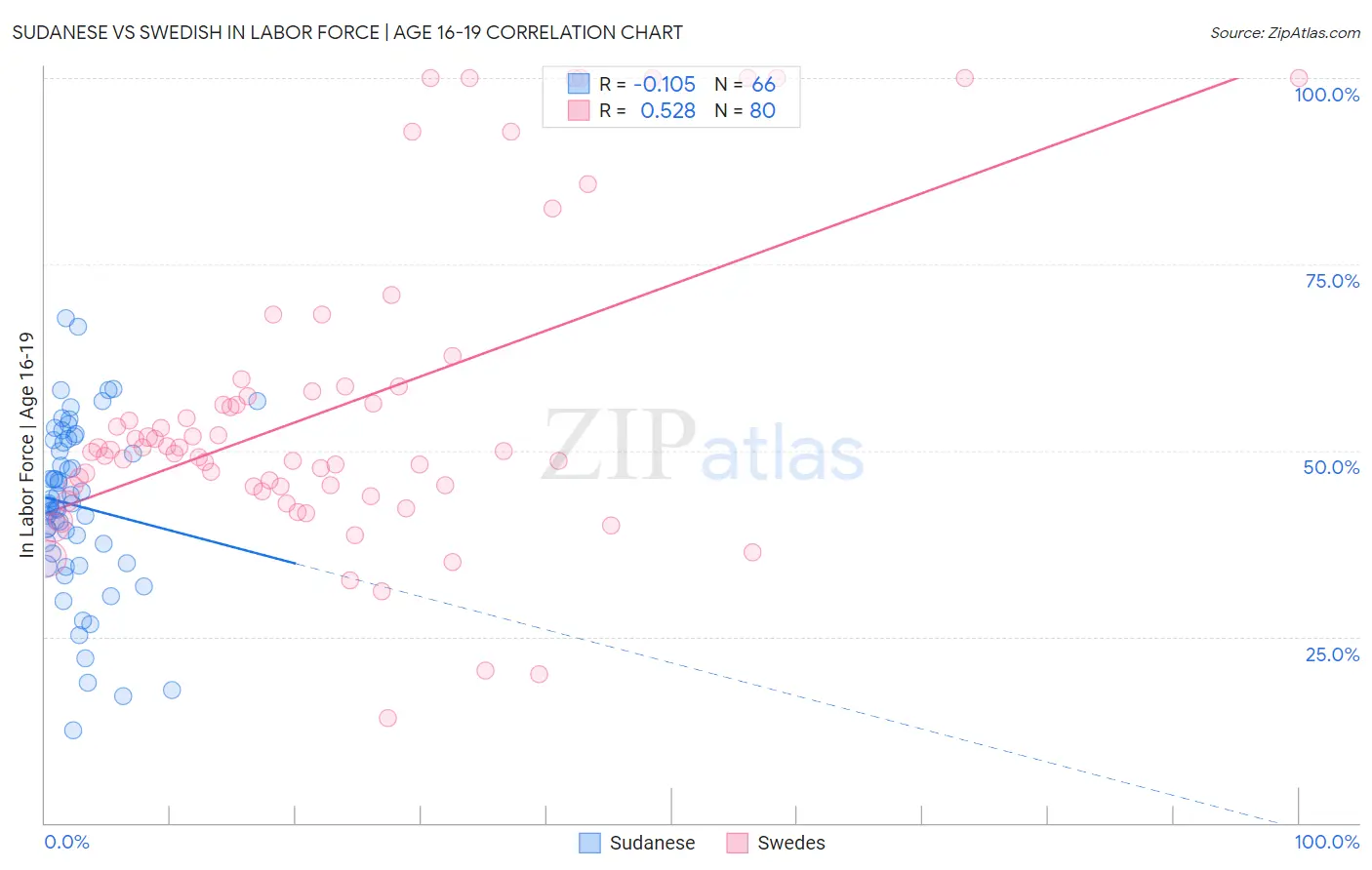Sudanese vs Swedish In Labor Force | Age 16-19
COMPARE
Sudanese
Swedish
In Labor Force | Age 16-19
In Labor Force | Age 16-19 Comparison
Sudanese
Swedes
42.9%
IN LABOR FORCE | AGE 16-19
100.0/ 100
METRIC RATING
22nd/ 347
METRIC RANK
44.1%
IN LABOR FORCE | AGE 16-19
100.0/ 100
METRIC RATING
11th/ 347
METRIC RANK
Sudanese vs Swedish In Labor Force | Age 16-19 Correlation Chart
The statistical analysis conducted on geographies consisting of 110,142,178 people shows a poor negative correlation between the proportion of Sudanese and labor force participation rate among population between the ages 16 and 19 in the United States with a correlation coefficient (R) of -0.105 and weighted average of 42.9%. Similarly, the statistical analysis conducted on geographies consisting of 536,421,636 people shows a substantial positive correlation between the proportion of Swedes and labor force participation rate among population between the ages 16 and 19 in the United States with a correlation coefficient (R) of 0.528 and weighted average of 44.1%, a difference of 3.0%.

In Labor Force | Age 16-19 Correlation Summary
| Measurement | Sudanese | Swedish |
| Minimum | 12.5% | 14.1% |
| Maximum | 67.8% | 100.0% |
| Range | 55.3% | 85.9% |
| Mean | 42.6% | 55.6% |
| Median | 42.8% | 50.0% |
| Interquartile 25% (IQ1) | 36.1% | 45.2% |
| Interquartile 75% (IQ3) | 51.4% | 58.3% |
| Interquartile Range (IQR) | 15.3% | 13.1% |
| Standard Deviation (Sample) | 11.5% | 20.5% |
| Standard Deviation (Population) | 11.4% | 20.3% |
Demographics Similar to Sudanese and Swedes by In Labor Force | Age 16-19
In terms of in labor force | age 16-19, the demographic groups most similar to Sudanese are Ottawa (43.0%, a difference of 0.40%), Slovak (42.6%, a difference of 0.59%), Bangladeshi (42.5%, a difference of 0.92%), Swiss (43.3%, a difference of 0.96%), and German Russian (42.4%, a difference of 1.0%). Similarly, the demographic groups most similar to Swedes are German (44.2%, a difference of 0.080%), Finnish (43.9%, a difference of 0.46%), Dutch (43.8%, a difference of 0.64%), Chippewa (43.8%, a difference of 0.75%), and Cape Verdean (44.5%, a difference of 0.82%).
| Demographics | Rating | Rank | In Labor Force | Age 16-19 |
| Somalis | 100.0 /100 | #6 | Exceptional 45.1% |
| Danes | 100.0 /100 | #7 | Exceptional 44.7% |
| Immigrants | Cabo Verde | 100.0 /100 | #8 | Exceptional 44.7% |
| Cape Verdeans | 100.0 /100 | #9 | Exceptional 44.5% |
| Germans | 100.0 /100 | #10 | Exceptional 44.2% |
| Swedes | 100.0 /100 | #11 | Exceptional 44.1% |
| Finns | 100.0 /100 | #12 | Exceptional 43.9% |
| Dutch | 100.0 /100 | #13 | Exceptional 43.8% |
| Chippewa | 100.0 /100 | #14 | Exceptional 43.8% |
| Slovenes | 100.0 /100 | #15 | Exceptional 43.7% |
| Czechs | 100.0 /100 | #16 | Exceptional 43.6% |
| Scandinavians | 100.0 /100 | #17 | Exceptional 43.6% |
| French Canadians | 100.0 /100 | #18 | Exceptional 43.6% |
| Belgians | 100.0 /100 | #19 | Exceptional 43.4% |
| Swiss | 100.0 /100 | #20 | Exceptional 43.3% |
| Ottawa | 100.0 /100 | #21 | Exceptional 43.0% |
| Sudanese | 100.0 /100 | #22 | Exceptional 42.9% |
| Slovaks | 100.0 /100 | #23 | Exceptional 42.6% |
| Bangladeshis | 100.0 /100 | #24 | Exceptional 42.5% |
| German Russians | 100.0 /100 | #25 | Exceptional 42.4% |
| English | 100.0 /100 | #26 | Exceptional 42.4% |